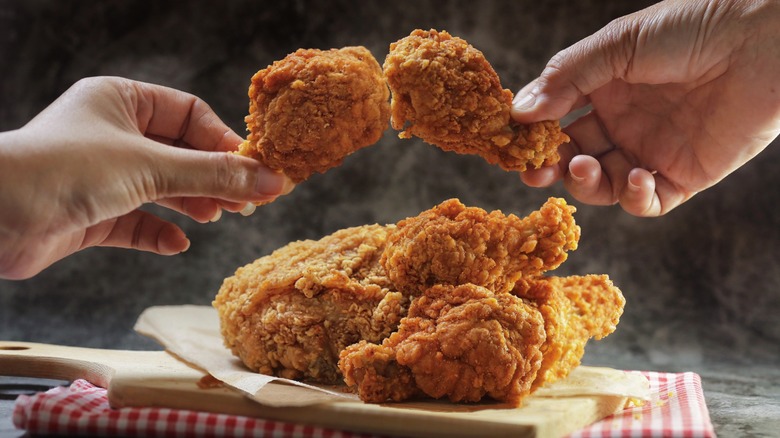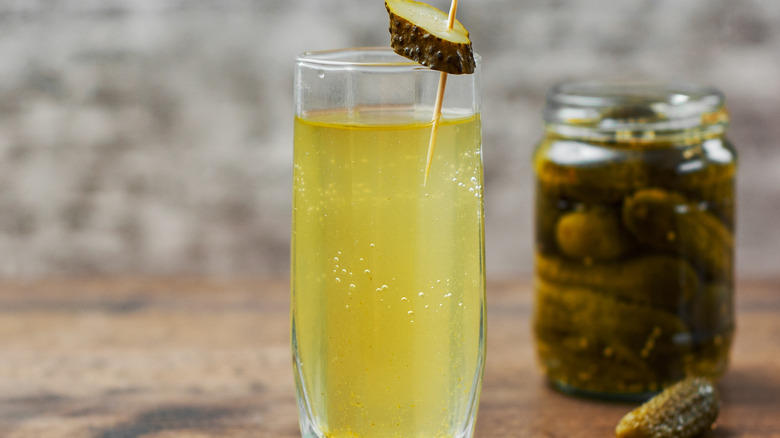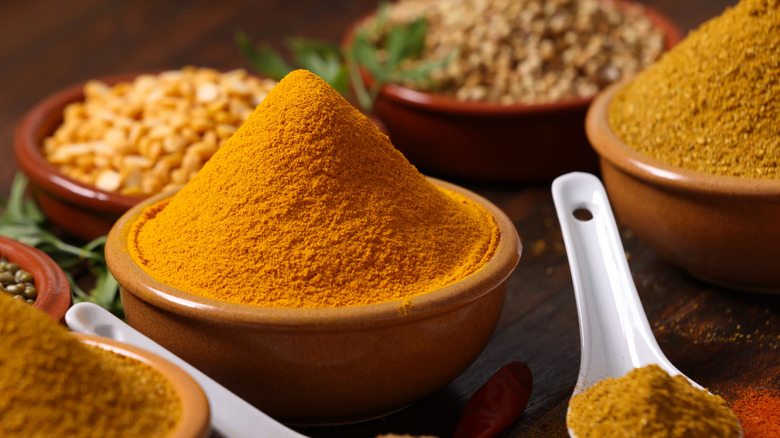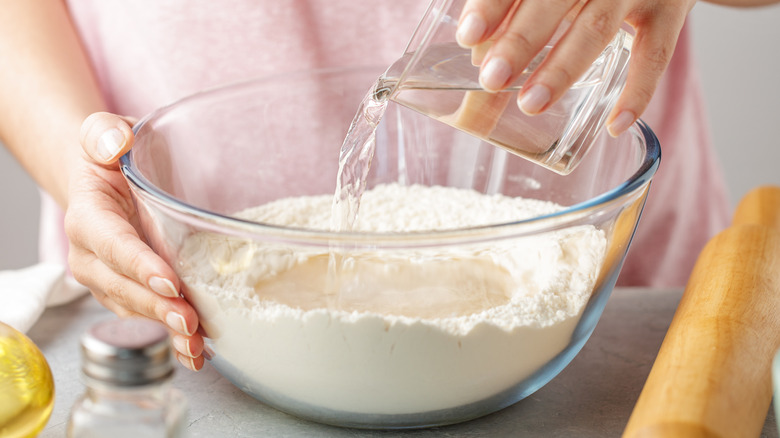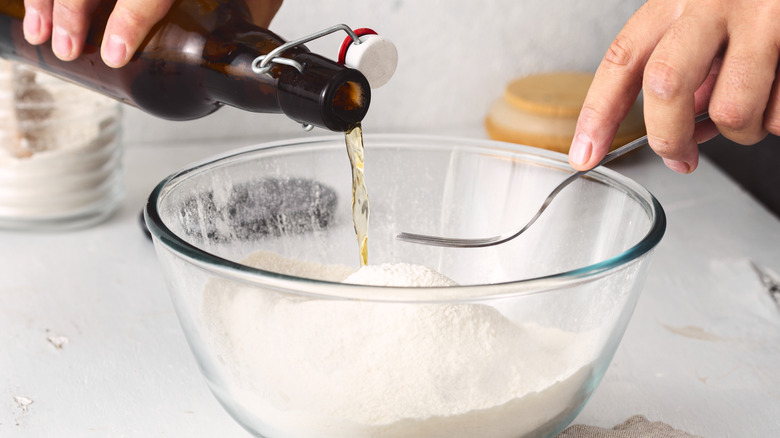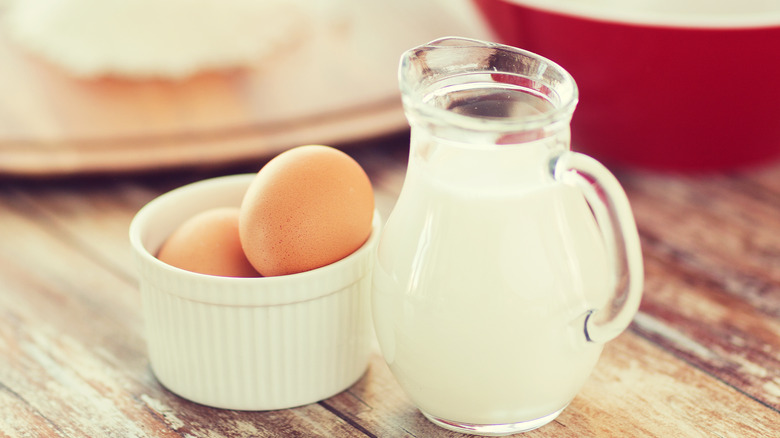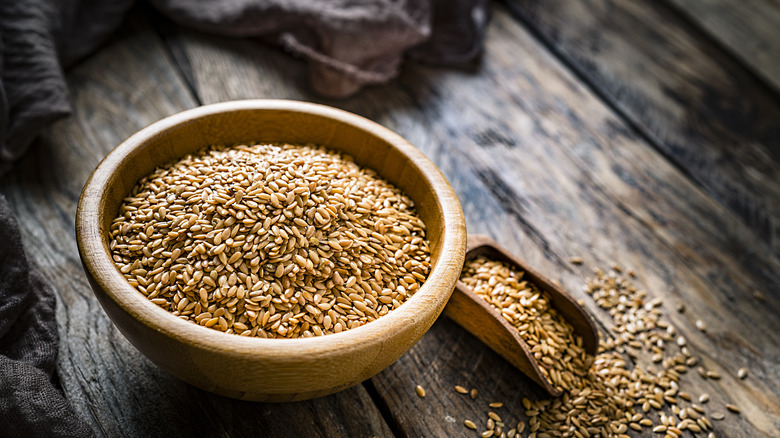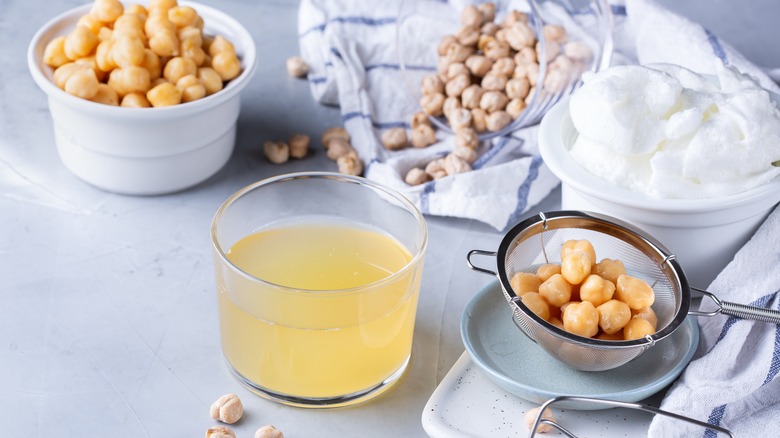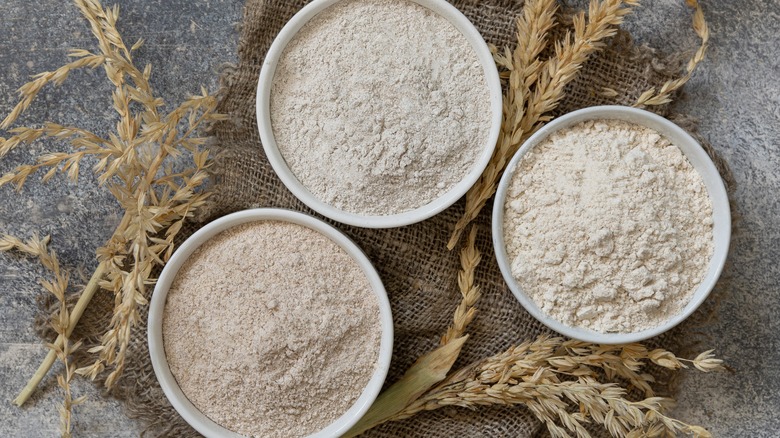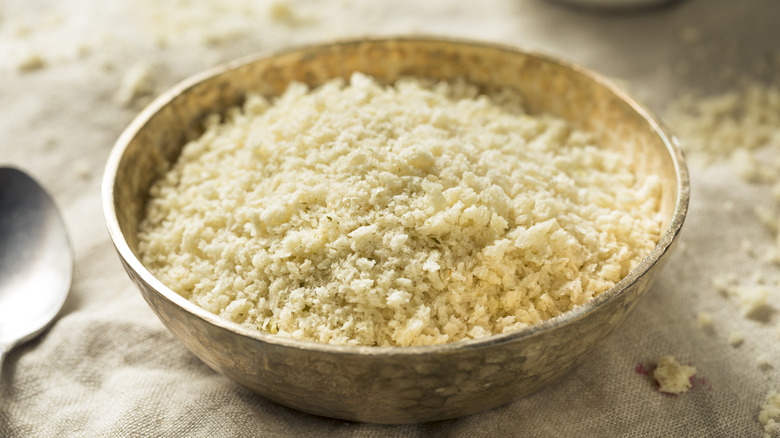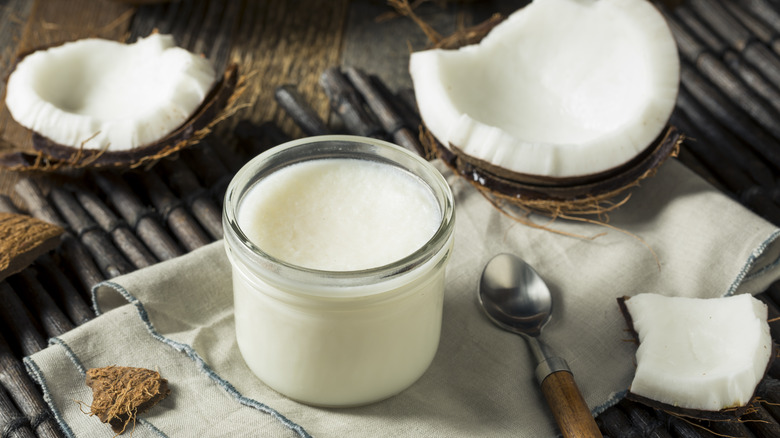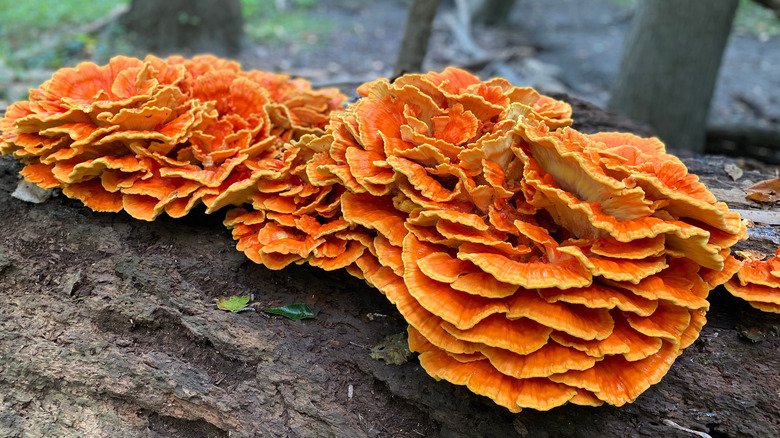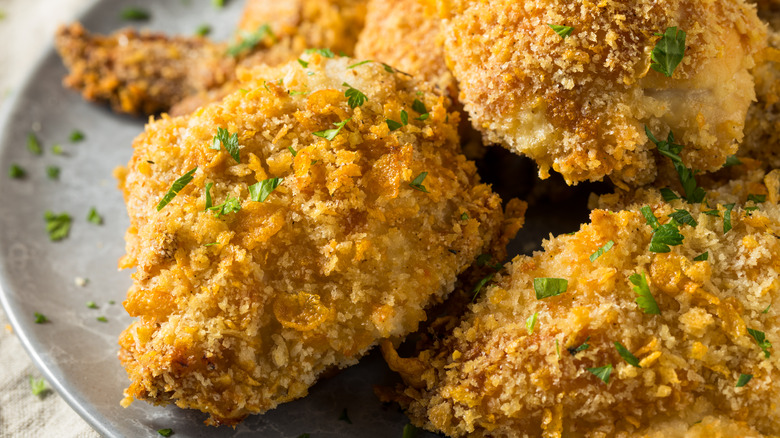Substitutes That Will Change The Way You Make Fried Chicken
Fried chicken substitutes are great in a pinch when you're missing an ingredient. Sometimes using substitutes results in finding better methods or ingredients you might like even better than the old way you've traditionally made fried chicken. We like the idea that there are so many ordinary ingredients you may have never realized could be repurposed for fried chicken. Once you know what works, it's easy to start with a traditional fried chicken recipe and build from there.
The substitutes we've listed here include not only flour and egg alternatives, but also different ways to brine and season your chicken, along with alternatives to the normal chicken-frying oils. We've even uncovered alternatives to chicken that actually taste like chicken. Plus, we've found a tasty alternative to cooking chicken that tastes like fried chicken without even frying. So, whether you're missing a key ingredient or are interested in learning new alternatives to change your fried chicken game, you'll want to keep reading.
Soaking in pickle juice brine instead of buttermilk brine
Home cooks and professional cooks alike have discovered that brining chicken before frying is the key to getting exceptionally moist and flavorful fried chicken. The brine you usually hear about the most contains tangy buttermilk. The acid in the buttermilk pulls apart the dense proteins in chicken, and traps the moisture of the buttermilk along with the salt. The salt helps it hold moisture and become tender by dissolving proteins, and helps carry the flavor of extra seasonings. If you're looking for a buttermilk brine substitute, you'll want something acidic and salty for the juiciest fall-off-the-bone fried chicken possible.
We've found that pickle juice can be a secret ingredient for fried chicken. Vinegar-based brines like pickle juice bring a similar brightness to the flavor profile that buttermilk does, and it's usually already salty. Adding a little sugar can assist with the Maillard reaction to give your fried chicken a beautiful golden crust. However, a lot of sugar could lead to burning the crust.
If you don't have pickle juice for brining, you can use a mixture of water, vinegar, and salt. Dill and other pickling spices are optional, but they can provide an added flavor level to your fried chicken. Such a pickle brine recreates the classic flavor of dill pickles on a fried chicken sandwich. You'll want to soak the chicken in the pickle juice (or pickle juice substitute) for at least 3 or 4 hours, or even overnight.
Seasoning fried chicken with curry instead of 11 herbs and spices
There are many copycat KFC chicken recipes out there, all promising to give you the secrets of Colonel Sanders' 11 herbs and spices. After a while, though, eating fried chicken that tastes the same as KFC's can be boring. It's classic, but there are more options out there. One that rocked our socks was trying to make curry fried chicken. It's just as comforting on fried chicken as it is in a sauce poured over rice.
There are several spice combinations you can use to make curried fried chicken. One way is to think of the base ingredients of a standard curry and go from there. Curries usually start with sautéed onions, ginger, and garlic, so you'll need onion powder, garlic powder, ground ginger, curry powder, and salt to season your chicken. For a spicier version, you can add ingredients like chili powder, black pepper, and cayenne pepper to the mix. To make a more Caribbean-inspired curry fried chicken, start with Jamaican curry powder.
We stumbled upon an inspired version of curry fried chicken by using a buttermilk brine and then seasoning the chicken with a mixture of S&B Golden Curry mix (a Japanese curry), Weber Zesty Lemon seasoning, garlic powder, and salt. The Zesty Lemon seasoning added brightness to the fried chicken, and the seasoning already contained garlic and onion flavors. We added extra garlic anyway because we believe you can never have too much!
Using a flour and water batter instead of using eggs
It's a common practice to dip chicken into a bowl of beaten eggs before coating the chicken with flour to help the flour stick to the chicken. But what do you do if you don't have any eggs? It turns out that the very best substitute for an egg wash is to just create a water and flour batter for your chicken. This method replaces dredging the chicken in eggs and flour.
The thickness of your batter is up to you. For a thicker crust, you'll want to go with a batter made from equal parts flour and water. For a thinner crust, you can increase the liquid-to-water ratio as much as two to one. This option is possible no matter which type of flour you use. You could even use cornstarch or arrowroot powder in this scenario.
The nice thing about this option is that it creates a great fried chicken crust without relying on other ingredients that could change the taste. Plus, using flour and water batter instead of an egg wash results in a thick, heavy, and extremely crunchy crust. So, you're not compromising quality or flavor.
Using beer to make a batter instead of water
Beer-battered fish is common, but what about beer-battered chicken? There are two ways to make it, and your choice depends on whether you want chicken that looks like battered fish, or if you want a flakey, crispy crust. While you can use any beer available, you'll get better results from a lighter beer, since a thicker, darker beer will overwhelm rather than complement the chicken flavor. So, think lagers, pilsners, and wheats instead of stouts and porters. You'll also want to use a super-cold beer straight from the fridge (or even the freezer) to make the crust as light and crisp as possible.
To make beer-battered fried chicken with a solid, non-craggy surface that will look like a Gorton's beer-battered fish filet, you'll simply make a beer batter from equal amounts of beer and flour, half a teaspoon of baking soda, and your seasonings of choice. You only need to dip the chicken into the batter to coat it before frying, with no extra dredging required.
If you're looking for a beer-battered chicken with a super-crispy crust, alternate dipping the chicken in beer batter and flour. Your first bowl will have a mixture of flour, salt, and your favorite fried chicken seasonings. Your second bowl will have a batter of flour, beer, salt, and beaten eggs. You'll dip the chicken first in the flour, then the batter, then the flour again. Repeat for even crunchier fried chicken.
Using dairy products instead of eggs
There are all kinds of dairy products you can use to adhere flour to chicken instead of eggs. You can also use dairy products instead of water if you want to make battered chicken. No matter what type of dairy products you have available to you, they will work just fine. So, what are your options? You can use milk, heavy cream, half and half, buttermilk, plain yogurt, or evaporated milk. You can even use sour cream, along with onion powder and chives to make sour cream and onion fried chicken.
As you can imagine, thicker dairy products help keep the flour on the chicken better and result in a thicker crust. Strangely enough, the thicker the dairy product, the less crunchy the crust tends to be. So, expect a much thinner but nicely crunchy crust with milk. Meanwhile, you'll get a thicker but less-crunchy crust with buttermilk and heavy cream. If milk is your only dairy product option, you might try thickening it up with a little mayonnaise. Another option is to turn your milk into buttermilk by adding a tablespoon of vinegar or lemon juice to a cup of milk, and waiting about 10 minutes for it to thicken. Keep in mind that deciding to use non-sweetened, non-dairy milk can end up altering the flavor profile of the chicken. For example, you should expect nut milk to give the fried chicken a nuttier flavor.
Using flaxseed instead of eggs
If you use flaxseeds to add more omega-3 fatty acids to your diet, you may not realize that they also make an excellent egg substitute. While we're more likely to think of using flaxseeds as an egg substitute for baking, their viscosity can also substitute for an egg wash when making fried chicken.
All you have to do is grind flax seeds and add a little water to turn them into the consistency of raw eggs. If you don't have pre-ground flax seeds, the best way to grind them is with a coffee grinder or mortar and pestle rather than a larger blender or food processor since you will only be grinding some flax seeds. You'll add a tablespoon of ground flax seeds to 3 tablespoons of water, and wait about 5 minutes for it to thicken. Once it's thick enough, you can use the mixture like an egg wash for dredging your chicken in flour and making it stick. Some people even go a step further and dip their chicken in whole flax seeds as a third layer to make flaxseed-crusted chicken.
Using flaxseed instead of eggs is almost as good of an option as making a water and flour batter. The results are fried chicken with a crunchy, medium-thick crust. While you may notice a slightly nutty flavor coming from the flax seeds, it's a possibility that you may like the nutty flavor better than the eggy flavor of an egg wash.
Using aquafaba instead of eggs
Aquafaba is a surprising ingredient you can use as an egg replacement for making fried chicken. If you have a can of beans in your cupboard, you have instant aquafaba because it's just the soaking water from beans. You can even whip it up like eggs to turn it into something that looks and acts like egg whites. The most common use of aquafaba to replace eggs comes from chickpeas (garbanzo beans) since the liquid is clear and has a reliable texture. However, you can use aquafaba from other beans as well.
You can also make aquafaba the long way by soaking and cooking dried beans, and collecting the bean water after it has cooled. Three tablespoons of aquafaba is the equivalent of an egg, and you'll want to use it when it's cool. Simply use the bean juice exactly like you would an egg. So, dip your chicken in the bean juice and then in flour before frying.
Using different types of flour
Using different types of flour for your fried chicken crust isn't just about choosing gluten-free options. Instead, the type of flour or flour additives you use can also influence the quality of your crust. Using cake flour or a mixture of half cornstarch and half flour reduces the amount of protein in your flour to give you an extremely crisp crust with an amazing crunch. To get a crust that's even lighter and crispier with a crust that shatters rather than crunches, you can skip the wheat flour and protein altogether and use just cornstarch, potato starch, or rice flour.
Many Southern cooks swear by using self-rising flour instead of all-purpose flour, with the idea that it will make a more expansive crust. If you don't have self-rising flour, you can add half a teaspoon of baking powder and half as much salt to regular flour. If you're looking for a crunchy and slightly sweet crust, try a mixture of equal parts finely milled cornmeal and flour.
Using breadcrumbs instead of flour
One way to get a satisfyingly crunchy crust without flour is to use breadcrumbs. While it's preferable to use both flour and breadcrumbs, you can get by with only breadcrumbs if you don't have flour. You still need to dip the chicken in egg first to get the breadcrumbs to stick. You may have to help the process along a bit by physically pushing the breadcrumbs into the chicken to help them stick. If you're using panko breadcrumbs, we suggest allowing the chicken to sit for 15-20 minutes before frying so that the eggs can soak more fully into the panko.
There's a difference between homemade and panko breadcrumbs. While you can make homemade breadcrumbs, panko breadcrumbs are the best choice if you have them. Panko comes ready to use, and is made from flaked and dried white bread, minus the crusts. Because panko breadcrumbs start drier, they won't soak up oil and make a soggy crust like homemade breadcrumbs tend to do. However, if you don't have any panko breadcrumbs at your disposal, you can air-dry bread cubes for 24 hours, and process them in a food processor or blender. Having a more bready than light and crunchy crust isn't a deal-breaker; it's just a different textural experience.
Using coconut oil instead of peanut oil or shortening
Peanut oil and shortenings are the most common types of fats people use for frying chicken. You need to use a type of fat with a high smoke point that is either saturated or monosaturated to remain stable at the high temperatures necessary for frying chicken (via Healthline). Vegetable oils like soybean and corn oils are polyunsaturated, and don't remain stable during deep frying. However, coconut oil meets both requirements for deep frying oil since it has a high smoke point and contains a lot of saturated fat.
There are a couple of things that you need to keep in mind if you use coconut oil. The first thing you need to do is be sure you're using refined coconut oil. The less refined it is, the more of a coconut flavor your fried chicken will end up having. While coconut-flavored oil might work okay for coconut fried shrimp, you probably don't want it on fried chicken. Luckily, the smoke point is higher for refined coconut oil. So, your oil can get as hot as 400 degrees Fahrenheit rather than needing to stay below 350 degrees Fahrenheit if you were using the refined variety. If you only have virgin coconut oil, you can still use it for frying, but you'll need to keep a watch on the temperature more closely so the oil doesn't burn and ruin your fried chicken.
Using mushrooms instead of chicken
If you prefer a vegetarian alternative to fried chicken, there are two types of mushrooms that taste similar to it — chicken of the woods and enoki. You're more likely to find chicken of the woods while foraging, while enoki mushrooms are often available in grocery stores (especially Asian markets). Chicken of the woods doesn't have lookalikes, so they're easy to identify even as a beginner when foraging food.
Chicken of the woods is the most popular mushroom substitute for fried chicken. If you're lucky enough to find young chicken of the woods, they will be tender enough to use as-is, while older mushrooms may need blanching or steaming first to re-introduce moisture. You can fry them up in the same way as fried chicken. People disagree about whether chicken of the woods tastes more like chicken or lobster, but they're good nonetheless.
Some people find fried enoki mushrooms taste like real fried chicken, while others detect more of a fishy flavor. One fun thing about frying up enoki is that they come in bunches of thin mushrooms, so eating fried enoki is more like getting fried chicken that's nearly all crust. There's still the underlying mushroom flesh, but the crust is the star because the mushroom is a mild one that absorbs the flavors around it. So, you'll want to use a flavorful mixture of spices in your batter. They're also great to pair with your favorite dipping sauce.
Making fried chicken in the oven instead of a fryer
While we love fried chicken, we don't like some of the inconveniences that come with it. This is why oven-fried chicken makes such a great fried chicken alternative. There's no need to make your house smell like the inside of a fried chicken restaurant, or invest in so much expensive oil when you can make chicken that tastes just as good in the oven. Plus, without using so much oil, it tends to be healthier.
There are a lot of recipes for crispy Southern oven-fried chicken that will have you making "fried chicken" at home more often. You can even use lower-smoking-point oils like olive oil and grapeseed oil. Unfortunately, we've found that simply flouring chicken and putting it in the oven doesn't produce a crispy crust like you find in fried chicken. So, the main trick for making crispy fried chicken in the oven is to use panko breadcrumbs with or instead of flour for your crust. The results are crisp and satisfying without all the work and mess.
